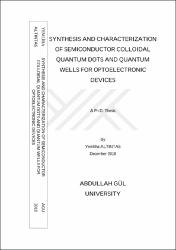| dc.contributor.author | ALTINTAS, YEMLİHA | |
| dc.date.accessioned | 2020-07-22T11:42:07Z | |
| dc.date.available | 2020-07-22T11:42:07Z | |
| dc.date.issued | 2018 | en_US |
| dc.identifier.other | Tez No: 542011 | |
| dc.identifier.uri | https://hdl.handle.net/20.500.12573/337 | |
| dc.description.abstract | In the last few decades, semiconductor quantum dots (QDs) have become one of the important branches of the nanomaterials thanks to their size (2-10 nm) dependent optical properties and excitonic features, narrow emission bandwidth, excellent photo and thermal stabilities. All these properties have named QDs as exotic nanomaterials for optoelectronic applications such as light emitting diodes, solar cells and colloidal lasers. The main focus of this thesis study is to demonstrate high quality and stable colloidal nanocrystals synthesis and present their optoelectronic applications. To realize this purpose, high quality, monodisperse and pure color emitting CdSe/ZnS QDs have been synthesized and high-quality white light emitting diodes (wLED) have been obtained by using free-standing flexible polymeric films of these QDs. The results obtained with these films have been presented both for display and lighting applications with white light parameters of NTSC color gamut of 122.5 (CIE-1931), CRI of 88.6, LER of 190 lm/Woptand CCT of 2763 K. In addition to CdSe based QDs, due to the environmental concern towards Cdbased nanomaterials, we focused our attention to Cd-free QDs as well. Evaluation and the performance of the QDs for various applications depend on their optical properties as QY, FWHM and tunable emission wavelength. To improve optical properties of the environmentally friendly QDs, various synthesis protocols and synthesis recipe have been used with different chemicals, precursor concentrations and structure. By the help ii of optimized precursor concentration and proposed structure of alloyed core/shell InPZnS/ZnS QDs, 78 % of QY and 45 nm of FWHM have been obtained by carefully designed synthesis recipe. The variation of the optical properties of the QDs have been characterized with steady state and time resolved photoluminescence (TRPL) analysis by monitoring the synthesis products at all stages of the synthesis. The lifetime of the alloyed core increased from 20.3 ns to 50.4 ns with shell coating by the suppression of the nonradiative decay components. For further improvements of Cd-free QDs synthesis, we have systematically studied the type and concentration of the Znprecursor. Green emissive QDs have been synthesized with 87% of QY, having 54 nm of FWHM. Emission kinetics and Förster Resonance Energy Transfer (FRET) efficiency between donor and acceptor pairs of the green and red emitting QDs have been investigated by using steady state and TRPL analysis. Efficient green emissive Cdfree QDs have provided 70.3 % FRET efficiency by mixing with red emissive Cd-free QDs in their polymeric film structure. As an alternative matrix to polymer structures to incorporate the nanocrystals, salt macrocrystals have recently emerged as an efficient platform to keep QY and optical properties of the emitters in their solid forms. FRET efficiency, photo-stability and white-LED performance of Cd-free QDs embedded salt pellets have been investigated by varying the acceptor to donor ratio in the salt matrix. 65% of FRET efficiency, 84.7 of CRI with 324 lm/Wopt of high LER has been achieved from pellets form of Cd-free QDs. We have also focused on the synthesis of the two-dimensional colloidal quantum wells to efficiently use them in optical gain and laser application. However, low QY and stability of the core/shell nanoplatelets (NPLs) that produced with c-ALD methods limits their performance in an application. So, first we have started to improve their optical properties and stability both in solution and film form. Finally, near-unity emitting CdSe/ZnS core/shell NPLs have been successfully synthesized by using hotinjection shell growth approach. Synthesized NPLs with our new synthesis protocol exhibited outstanding photo, thermal-stability and optical gain performance with lasing thresholds as low as 7 µJ cm-2 . | en_US |
| dc.language.iso | eng | en_US |
| dc.publisher | Abdullah Gül Üniversitesi | en_US |
| dc.rights | info:eu-repo/semantics/openAccess | en_US |
| dc.subject | semiconductor nanocrystals | en_US |
| dc.subject | quantum dots | en_US |
| dc.subject | optoelectronic applications | en_US |
| dc.subject | colloidal gain | en_US |
| dc.subject | white-LED | en_US |
| dc.subject | FRET | en_US |
| dc.title | Synthesis and characterization of semiconductor colloidal quantum dots and quantum wells for optoelectronic devices / | en_US |
| dc.title.alternative | Optoelektronik aygıtlar için yarıiletken kolloidal kuantum noktaları ve kuantum kuyularının sentezi ve karakterizasyonu | en_US |
| dc.type | doctoralThesis | en_US |
| dc.contributor.department | AGÜ, Fen Bilimleri Enstitüsü, Malzeme Bilimi ve Makine Mühendisliği Ana Bilim Dalı | en_US |
| dc.contributor.institutionauthor | ALTINTAS, YEMLİHA | |
| dc.relation.publicationcategory | Tez | en_US |


















